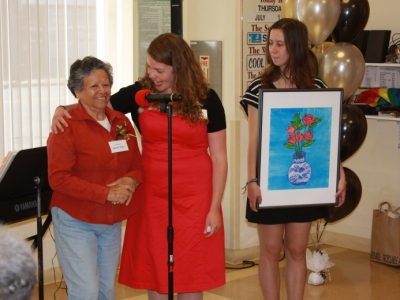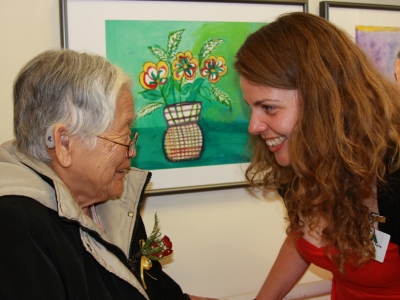Today we talk with Talitha Guinn, Director of Elder Abuse Prevention at the Institute on Aging here in California. We address the under-acknowledged and multi-faceted issue of elder abuse — what it is, how to detect it, how to prevent it and how to intervene and stop it.
The Institute on Aging provides programs in health, social service, creative arts and community and professional education to enhance the quality of life for adults as they age by enabling them to maintain their health, well-being, independence and participation in the community. IOA’s Elder Abuse Prevention Program promotes public awareness on elder abuse issues, provides training and education to seniors and professionals and advocates for policies and services that increase safety for vulnerable adults.
 Dana: Can you give a brief overview of your work with the Institute on Aging for our readers who are unfamiliar?
Dana: Can you give a brief overview of your work with the Institute on Aging for our readers who are unfamiliar?
Talitha: I am the director of Elder Abuse Prevention at the Institute on Aging, and I also direct the San Francisco Elder Abuse Forensic Center. The goal of the Elder Abuse Prevention program is outreach and awareness about elder abuse issues. Our services can be lumped in four areas:
- Education and training
- Community outreach, which are ad campaigns and outreach
- Strategic partnerships, for example with the Elder Abuse Forensic Center. The Forensic Center is a public-private partnership with the Institute on Aging and the city of San Francisco. We try to coordinate and investigate the most egregious instances of elder abuse. When we receive a report of suspected elder abuse, we hold case consultation meetings with multiple professionals to consult and send people out on coordinated home visits. For example, we’ll send a social worker out with a psychologist, and we might send a geriatrician for a medical evaluation.
Dana: What forms does elder abuse take?
Talitha: It takes many forms. The most common form that elder abuse takes is neglect. When people see this, they often say, “Well, they’re not being abused, just neglected.” But neglect, particularly under California law, is a form of abuse. It’s the most egregious form, and the one they’re most likely to die from.
Abuse can also be physical, financial or there’s domestic violence in later life. Sexual abuse occurs, and elders are victimized for many of the same reasons as children are — they’re vulnerable, they have less of a safety net to fall back on and people may not believe them when they say they’ve been abused.
Dana: What does a forensic team look for when they’re sent out to investigate suspected abuse?
When we send a team out, there’s already suspected abuse, so they’re looking for something that will further a prosecution or police investigation.
Dana: What about the general public? What can we look for as signs of possible abuse?
Talitha: One of the major risk factors for elder abuse is isolation. When someone is isolated, this can lead to abuse and neglect. Abusers will systematically isolate someone to financially exploit them, for example block phone calls or mail from reaching them, encourage them to cut off contact with family, saying “they don’t care about you anymore” or something like that.
Signs of financial abuse may be unpaid bills, utilities being cut off. Are there items this person should be able to afford and need but don’t have, like medication, a walker, or other assistance? Is there a caregiver or family member who is verbally abusive in front of you? Most of us have filters that tell us how we should act around people, but oftentimes abusers’ stands are shifted so that abusive behavior has become normalized.
You can often detect signs of neglect by observing the home — are newspapers or mail piling up, is there a lack of attention to the home, especially if the person usually takes a lot of pride in in? Are there odd noises or bad odors? When you see the person, do they look malnurished or dehydrated? Bed sores can be a sign of neglect. They’re not always, but look for whether it’s being properly treated or not.
 Dana: What do you suggest people do if they suspect elder abuse?
Dana: What do you suggest people do if they suspect elder abuse?
Talitha: People can call adult protective services. It’s mandated by the federal government to be in every county in the country. They’re 24/7, they speak multiple languages and it’s completely confidential, so you don’t have to share your name or any information if you call. They are composed of social workers and nurses, and have to investigate a report of abuse within a set timeframe of you calling.
Dana: What do you teach seniors to help prevent elder abuse?
Talitha: When I go out to community organizations — retirement groups, senior centers, anywhere seniors gather — I do presentations on what to look for if you’re concerned about a family member or loved ones. People who are getting out to senior centers and are active like that are less likely to be abuse victims themselves, but they can keep an eye out for their more isolated peers.
We teach seniors how to be aware of and to protect themselves from financial abuse and scams. Financial abuse is on the rise, and seniors are particularly targeted for scams. We teach about common scams and ways to avoid them.
Dana: What do you teach the public to help prevent elder abuse?
Talitha: Well, when we say “the public,” we’re talking about outreach to seniors, because they are the elders who could experience abuse or their peers could be experiencing abuse. The other group we reach out to are professionals. We teach them about identifying and reporting elder abuse and how to work with the various agencies that may get involved — the local police, social services, etc.
Dana: Do you have trouble presenting on these issues and addressing them because of the array of forms elder abuse can take? For example, I would imagine it to be tough to address sexual abuse in the same conversation as financial abuse.
Talitha: I haven’t found that be a problem. We usually pitch this information as ways to protect yourself in general, and then we discuss the various types of abuse and what we see happening in the community. Once we get talking about these issues, people become interested in talking about it and begin asking questions and want to learn more, so it’s not difficult to talk about.
From a intervention standpoint, though, it can be difficult to talk about because of how faceted the issue is, yes.
Dana: Do you see that various forms of abuse often occur together?
Talitha: Absolutely. Neglect and emotional abuse often happen along with financial abuse, for example. Often the way abuse comes to light is, for instance, a bank reporting suspected financial abuse — they’re mandated reporters of financial abuse — and physical abuse or neglect will come to light as well.
Dana: Is there anything else you’d like to share that I haven’t mentioned?
Talitha: I think the important thing for the public to know is that prevention and intervention work. You can take steps to protect yourself, and if it has happened, there’s help. Adult Protective Services is a very useful tool to help the community. They’re experts, and they can assist with a lot of care and really help find remedies.
For more information, see:
- Local and national elder abuse prevention resources
- Fact sheet from the San Francisco Elder Abuse Forensic Center
- Elder Abuse Fact Sheet from the Institute on Aging
Images from IOA events, courtesy of the Institute on Aging.

 How Can We Detect and Prevent Elder Abuse? An Interview with Talitha Guinn
How Can We Detect and Prevent Elder Abuse? An Interview with Talitha Guinn



 Composting Bodies Is Now Legal in a Dozen States
Composting Bodies Is Now Legal in a Dozen States
 “Hand to Earth” by Andy Goldsworthy
“Hand to Earth” by Andy Goldsworthy














